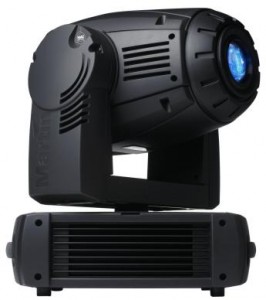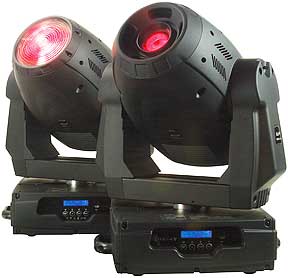Moving Heads
Intelligent lighting refers to stage lighting that has automated or mechanical abilities beyond those of traditional, stationary illumination. Although the most advanced intelligent lights can produce extraordinarily complicated effects, the intelligence lies with the programmer of the show rather than the instruments or the lighting operator. For this reason, intelligent lighting is also known as automated lighting, moving lights or moving heads.
Intelligent lights, can be used wherever there is a need for powerful lighting which must be capable of rapid and extreme changes of mood and effects. Moving heads would, therefore, be inappropriate in a setting which does not require strong lighting (such as a small drama piece).
Passive use of automated lighting involves utilizing their versatility to perform tasks which would otherwise require many conventional lights to accomplish. For example, six to eight moving heads can create a textured blue “night” effect on the stage floor while applying amber light to the actors during one scene – this can create a sensation of dusk or night. At the flick of a switch, the fixture can change to an animated red “fire” effect for the next scene. Attempting this transition with traditional lighting fixtures could require as many as thirty instruments. In this circumstance, the automated fixtures are not doing anything that could not be achieved using conventional fixtures, but they dramatically reduce the number of lights needed in a rig. Other features of automated fixtures, such as rotating gobos, are also possible with conventional fixtures, but are much easier to produce with intelligent fixtures.
Active use of automated lights, suggests that the luminaire is used to perform tasks which would otherwise require human involvement, or be simply impossible with conventional fixtures. For instance, a number of moving heads producing tightly-focused, pure white beams straight down onto the stage will produce a fantastic effect, especially if a smoke machine or hazer is used to make the beams visible.
Moving head fixtures are often divided into spot and wash lights. They vary in use and functions but many companies offer profile and wash variants of the same model of light. Profile lights generally contain features like gobos and prisms, whereas wash lights have simpler optics and a wider beam aperture resulting in wider beam angle, which may be altered by internal lenses or “frost effects”. Wash lights are more likely to have CMY colour mixing although it is common for high-end spot lights to have such features too. Spot units are generally used for their beam effect (usually through smoke or haze) and the ability to project texture, whereas wash lights tend to be used for providing a stage wash.
Manufacturers
There are several well known manufacturers of moving lights, including Martin, Vari*Lite, Clay Parky and High End Systems. An emerging range of products from lesser known manufacturers is driving the price down. These manufacturers include Robe, Eurolight, Coemar and Pearl River

